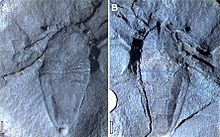| Phalangiotarbida Temporal range:
| |
|---|---|

| |
| Goniotarbus angulatus fossil, dorsal and ventral views | |

| |
| Reconstruction of Goniotarbus angulatus and Mesotarbus peteri | |
| Scientific classification | |
| Domain: | Eukaryota |
| Kingdom: | Animalia |
| Phylum: | Arthropoda |
| Subphylum: | Chelicerata |
| Class: | Arachnida |
| Order: | †Phalangiotarbida Haase, 1890 |
| Families | |
|
Currently 4 families, see text for details. | |
| Synonyms | |
|
Architarbi | |
Phalangiotarbida is an extinct arachnid order first recorded from the Early Devonian of Germany and most widespread in the Upper Carboniferous coal measures of Europe and North America.[1] The last species are known from the early Permian Rotliegend of Germany.
The affinities of phalangiotarbids are obscure, with most authors favouring affinities with Opiliones (harvestmen) and/or Acari (mites and ticks). Phalangiotarbida has been recently (2004) proposed to be sister group to (Palpigradi+Tetrapulmonata): the taxon Megoperculata sensu Shultz (1990).[2]
Nemastomoides depressus, described as a harvestman in the family Nemastomoididae, is actually a poorly preserved phalangiotarbid.[3]